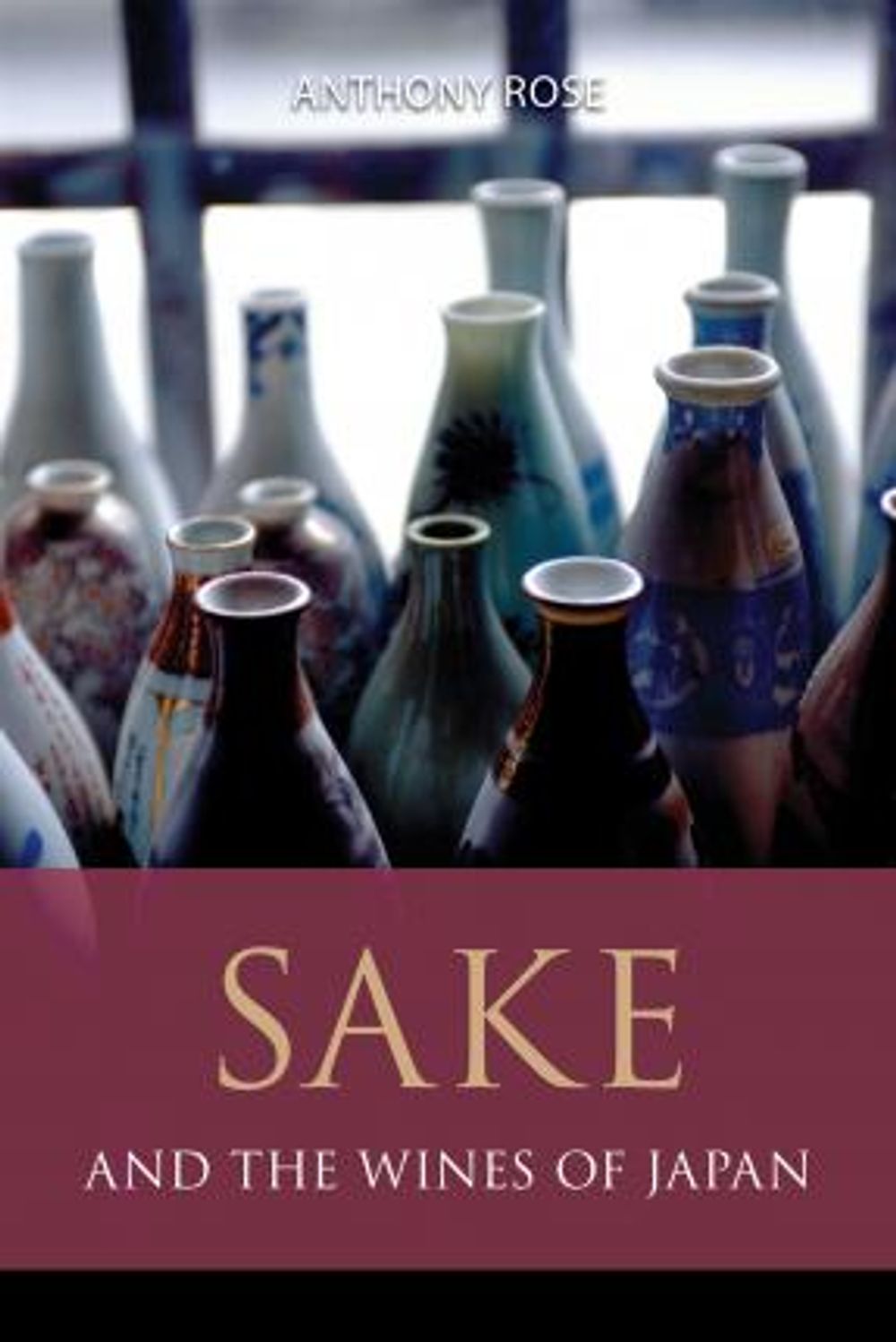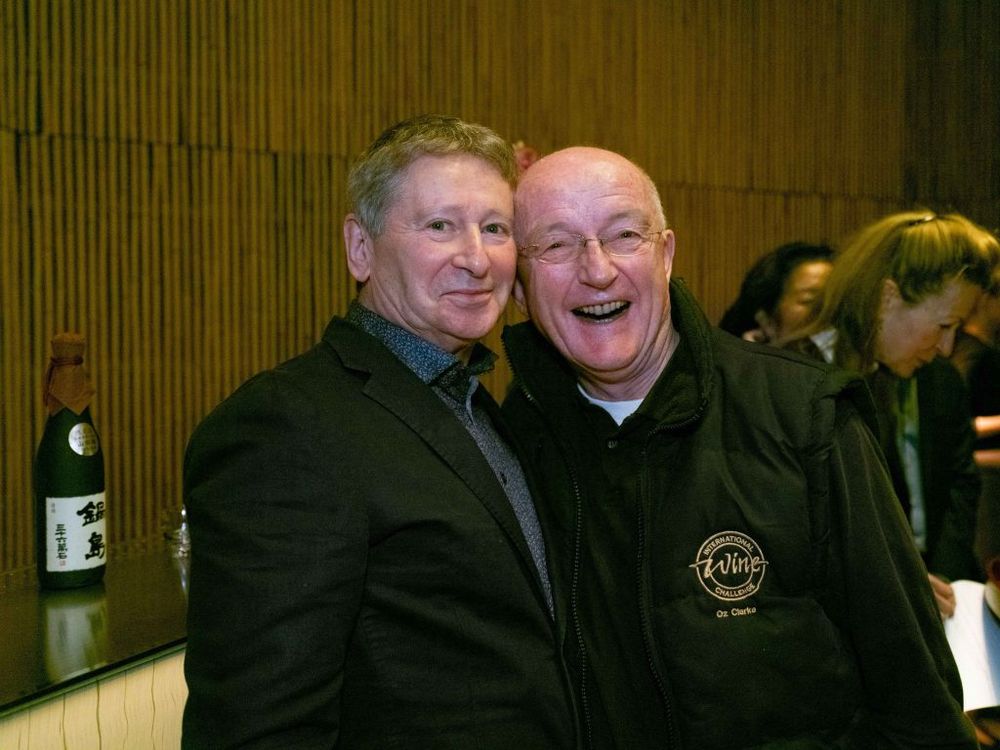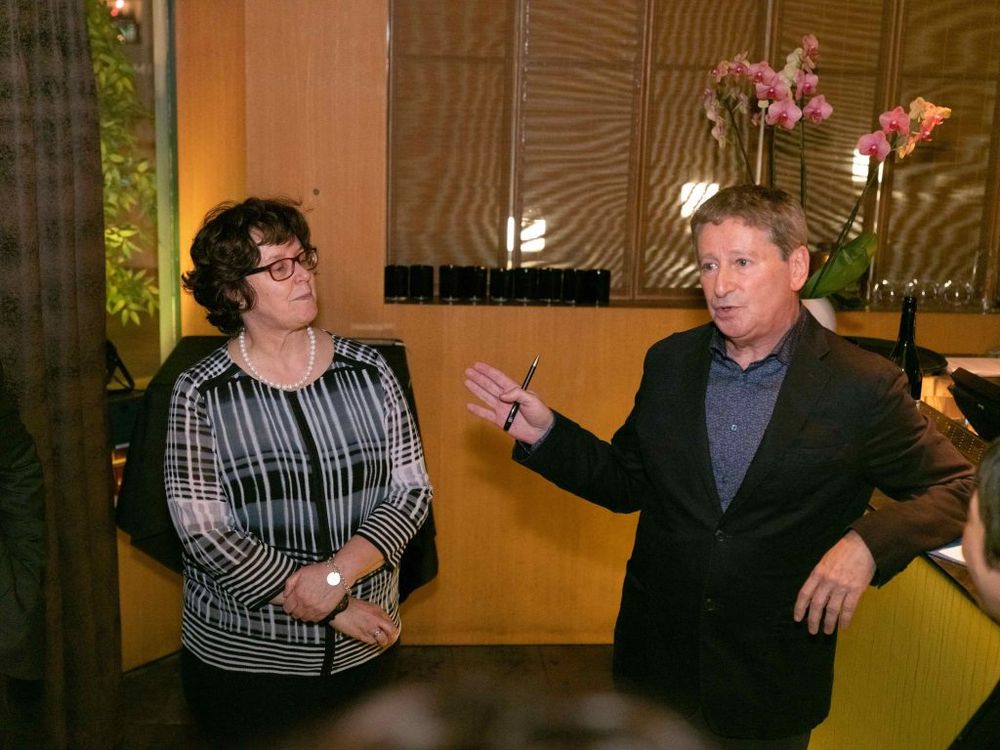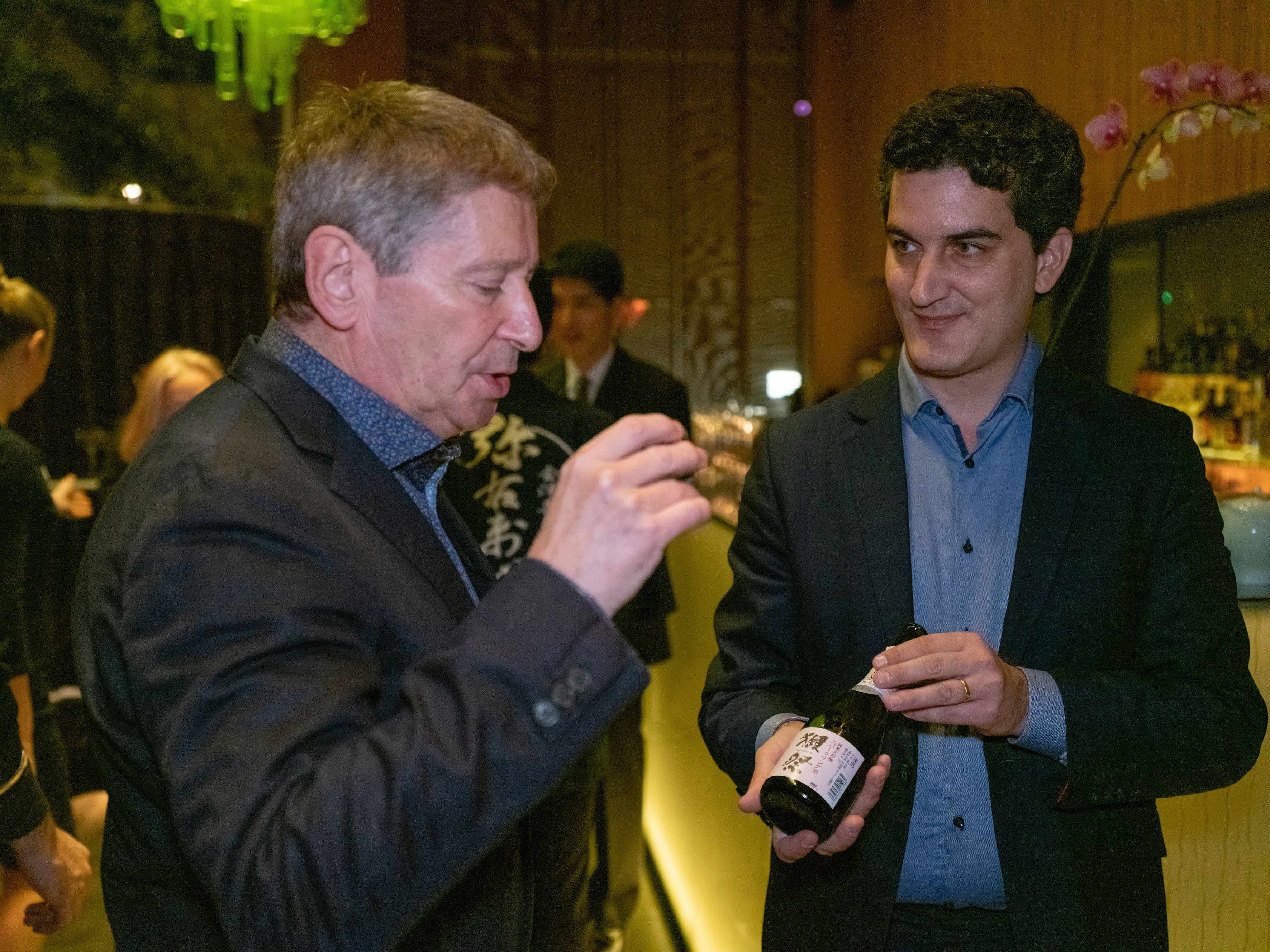Anthony Rose believes a book aimed at a western audience on the wonders and intricacies of Japan, sake and its wines is long overdue. So he decided to go out and write one himself.

Anthony Rose raises a glass at the book launch for Sake And the Wines of Japan
Sake? It’s clearly a fascinating drink but why did you think there was a book in it?
The first of many books on a subject in urgent need of attention? Where do I start? Well, first of all, if you read the book, I think you’ll see why. Sake is a rich seam of liquid enjoyment that’s virtually untapped with a woeful lack of information on it in the English language. And this at a time of crescendoing interest in Japan’s national drink. There’s a lot to talk about: the history and culture of Japanese sake, the production process and the many links in the production chain, from rice field all the way through to the bottled product and the diversity of grades and styles of sake, and of course the amazing individuals and families behind it.
There are parallels, and equally differences, with wine, in issues such as regionality, climate and geography and rice varieties, not to mention the significance of the elements of water, yeast and the koji mould that transforms rice starch into fermentable sugars. For the geeks of this world, the technical detail is mind-boggling (there are appendices in the book for all that stuff).
Who is the book aimed at?
It’s meant to be a read, so it’s for everyone, though you might loosely sub-divide potential readers into four groups. The first group is the reader who knows little or nothing about sake but would like to find out more, so I’m aiming to communicate the enjoyment and understanding of sake in as unstuffy and easy-to-understand way as possible. Secondly it’s for those who already know sake and students who want to delve further into the subject. Thirdly it’s aimed at the trade, on and off, interested in finding out more about the benefits of stocking sake or adding it to their list. And finally, with 100+ profiles and a section on navigating Japan and Tokyo restaurants, bars and hotels, it’s aimed at the traveller to Japan (including a section on Japanese wine and wine tourism).
What was the objective in writing the book – what did you hope to cover and achieve?
Despite the growing interest in Japanese sake in the West, there has been surprisingly little communication about a traditional drink, whose newly flourishing premium sector is hitting its straps in Japan and on export markets after a lengthy post-war decline at the volume end. The aim of the book is to communicate the enjoyment and understanding of sake in an unstuffy and easy-to-understand way by reference to its place in history and culture and by explaining the many ways in which sake is best enjoyed, from drinking and tasting to in situ visiting.
I aim not only to draw readers into a greater appreciation of Japanese sake itself, but also to shine a light on Japan and Japanese culture. With the Rugby World Cup next year, Tokyo 2020 and the 2021 Paralympics, that’s why, with 100+ profiles, a big chunk of the book deals with visiting sake breweries with recommendations of restaurants, sake bars, wine bars and hotels as well as a section on Japanese wine and wine tourism.
How did it come about?
The book was the brainchild of the publisher, Richard Burton at Infinite Ideas, who thought that there was a need for it and that it would fit perfectly into their Classic Wine Library Series. Early last year, Richard asked me if I would like to write a book on sake and I wasn’t going to pass up such an opportunity to be an advocate for a drink whose time has come.
Explain how you went about researching and writing the book?
I have been visiting Japan regularly for over 10 years ago now, initially as a judge at the Japan Wine Challenge in Tokyo in 2007. That brought me into contact with the International Sake Challenge, of which I have since become a co-chair.

Initially, though, we were thrown in at the deep end. I didn’t have a clue, nor was I particularly interested in sake. At the end of the judging week, a group of us went out for dinner and someone ordered a sake. I have no idea whether it was even a good one or not, but all of a sudden, I found myself enjoying it. Very much in fact. It was my ‘conversion on the road to Asakusa’. It happens to some people, while others come to it gradually and others still have yet to appreciate sake. Hopefully, the book will help.
During the time I have been involved in the competition, I have been on sake brewery visits in many of (but not all yet) Japan’s 47 prefectures, and of course sampled the product extensively.
As well as tasting on my visits, I interviewed brewery owners and sake makers for the profiles to gain a deeper understanding of what makes sake tick and why, in its modern manifestation, it’s become such an intriguingly diverse and enjoyable drink. Many of the smaller family craft sake brewers don’t speak any English, so I was lucky enough to have the services of Kazumi Suzuki, who works for the World of Fine Wine, to ensure that nothing got lost in translation.
Any particular areas of sake that you would like to highlight to draw the trade and buyers in to not just reading the book but buying and listing sake for their ranges and drinks lists?
Yes, first of all I think it’s important to stress that the revolution in sake style and quality of the past decade has largely come about through a renewal of pride in the product largely cultivated and promoted by the younger, open-minded generation of brewers. Their experience of a world beyond Japan has taken sake out of its shell and made it relevant not just to younger drinkers in Japan, who once regarded it as a drink just for their parents, but overseas as well.
In tandem with this movement is the development of sake breweries outside Japan (there’s a chapter on that, including profiles of sake breweries in the US, Spain, Norway and the UK) and the adoption of sake culture by such luminaries as the Berlin D.J., Richie Hawtin, who has his own company Enter.Sake, by Régis Camus, chef de cave of Charles and Piper Heidsieck, and by Richard Geoffroy, chef de cave of Dom Pérignon, who’s so convinced of a great future for sake (he’s written the foreward) that he has established a joint venture with the Masuizumi Brewery in the Toyama foothills.
One of the best ways to communicate the pleasures of drinking sake is through food, and I aim in the book to dispel the myth that sake is a drink just for Japanese food. On the contrary, sake, with its many styles and the ability to drink it at different temperatures, is an incredibly versatile drink that dares to venture where many wines fear to tread. It can happily take in cheese, hotpots, curries, shellfish and strong fishy flavours such as anchovy and smoked fish.
From a time when only Japanese importers brought sake into the UK, a new band of British importers such as Sam Sake and tengusake, has sprung up alongside UK specialists, Bibendum and Liberty Wines for instance, whose aim is to make sake more accessible by bringing it into the mainstream. These importers have helped to make sake packaging far more intelligible, often with good back labels full of useful information about the liquid inside.

Anthony Rose celebrating at his book launch with fellow wine writer and author, Oz Clarke
What styles of sake do you think are best suited to the UK market and why?
The new trendy styles of sake such as sparkling sake and low alcohol sake (even sake-based cocktails) can be a starting point for people who haven’t experienced sake before or who may have tried it but were put off by tasting an inferior product. The basic sakes sold by one or two supermarkets are not helping the sake cause, and I anticipate that through a combination of smaller bottle sizes and the introduction of own-label premium sakes, this will change. Whole Foods are good on smaller bottle sizes. Broadly though, I think it’s the premium sector of aromatic ginjo sakes and food-friendy junmai sakes that will win many new friends in the longer term.
What price points do you think sake performs best at?
Price is a problem on overseas markets because a combination of transport costs, duty, margin and small-scale importation. In Japan, sake is much more reasonably priced than in the UK, to the extent that there’s a debate in the industry currently as to whether sake’s too cheap. I wish I could say the same in the UK, but it’s going to need a critical mass of imports to bring prices down to more reasonable levels, and some brave retailer such as M & S to do an own-label sake or the Wine Society to do an Exhibition Sake. To be honest, I am surprised the Wine Society don’t do one already. I feel sure there’d be demand for a good, well-priced sake, perhaps in 300ml or half-litre bottle, at around the £10 mark.
How easy is it to understand the various grades?
The grades are legal categories based on polishing rates, i.e. the amount the outer part of the rice grain is milled away to prepare it for the fermentation process. The more the rice grain is milled away, the higher the grade. That’s pretty easy to follow, isn’t it? Where the lines becomes a little more blurred is relating the sake grade to style and quality. On the face of it, the higher the grade, the better the quality, but there’s many a slip in that argument between sake cup and lip.
Can inexperienced sake drinkers recognise the difference if they start buying premium sake? Good question. Can an inexperienced wine drinker recognise the difference if they start buying fine wine? The more premium or high quality the sake, the more flavour intensity and the greater the texture and length it tends to have (although counter-intuitively, a short finish can be a virtue in sake), so in that sense, I would say yes, even an inexperienced sake drinkers can tell the difference. I once gave a beautiful premium sake to someone who’d barely tasted sake before. It was love at first taste. That may not happen every time but on our course for instance, most beginners leave wanting to learn – and drink – more.
What is your own particular favourite style of sake and why?
I started out particularly liking daiginjo and ginjo sake because of its beguiling fragrance, freshness and and delicacy, and I still love many a ginjo and daiginjo sake, especially the drier styles emanating from the northerly prefectures of Niigata, Yamagata and Akita. As time has passed though, I have started to appreciate sakes with more umami content, that savouriness that makes them so delicious with food, and not just sushi and sashimi. So today, I’m enjoying as much premium junmai and honjozo sake as the higher grades. They are also more reasonably priced, and the Austrian glass manufacturer, Riedel, has developed, in conjunction with the industry, a fine new junmai glass to bring out the textures of junmai sake that the small sake cup, the ochoko, can’t always do.

Anthony Rose says influential figures such as Christine Parkinson at Hakkasan are doing so much to bring sake to a wider audience
What good food matches are there with sake other than Japanese cuisine?
I’m glad you asked me that because the best way to enjoy sake is with food, and I mean Western food as much as Japanese. With its myriad styles and the ability to drink it at different temperatures, sake is a versatile drink that matches not just the usual suspects of sushi and sashimi, but all sorts of dishes from the subtle to the strong-flavoured.
Let’s not forget that Japanese cuisine is much more varied than often thought, encompassing a wide range of types of cooking beyond sushi and sashimi, from tempura, yakitori, sukiyaki, tonkatsu, okonomiyaki and shabu-shabu to teppanyaki, soba and udon. If I can paraphrase parts of the chapter in the book on enjoying sake, sake’s texture enhanced by umami makes it a natural partner for food, with subtle sweetness bringing out the salinity in seafood and shellfish, umami complementing it in tomatoes, parmesan, mushrooms, truffles, anchovies, Parma ham, Jamón Ibérico, chorizo, meat and fish stock, Marmite, cheese and green tea, for instance. Sake can cope with pickles and vinegary dressings where a wine might struggle. Curries and cheese are among some of the surprisingly good matches for sake.
In particular, fragrant fresh aromatic sakes in the ginjo group pair well with seafood, shellfish and white meats. The savouriness of the more umami-laden junmai types of sake makes them well-suited to a range of dishes with, for instance tomatoes, mushrooms, truffles or anchovies, Jamón Ibérico, meat and fish stock, soups as well as cheeses and curries.Sake has roughly one-fifth the acidity of wine and so its gentle textures go well with food that partner well with a wide variety of foods. Equally, there are none of the do’s and don’ts too often associated with food and wine matching. So, starting with a clean slate, just about anything goes. Sake is also often available in 300 ml and half-litre sizes, which adds to its versatility on a restaurant list.
Hot or cold? Until I went to Japan, I was led to believe that hot sake was naff, something that American tourists asked for because it masked sake faults. That may have been true 20 years ago, but I learnt when I went to Japan that there are ‘three drinks in every bottle’, sake drunk chilled, at room temperature, and hot, and this is one of the features that distinguishes it from wine. You tend to drink ginjo sakes chilled, but when it’s cold outside, or with dishes such as hotpots, pork ribs and soups, sake drunk warm or hot can be comfortingly delicious. On our course we always have at least one sake with the lunch which is served both chilled and hot, and then we take a vote as to which is preferred. It usually comes down to 50:50. What is the most unusual sake that you have come across? There are lots of quirks in sake, especially in the styles made by the traditional yamahai and kimoto methods and there are also many that don’t conform to any idea of what you think sake should be. Taruzake (cedar-aged) sake that replaces that taste of sake shipped centuries ago in cedar barrels is pretty unusual and not to everyone’s taste, equally the dry, wine-like Aramasa Ama-Neko, but perhaps the most unusual I’ve tasted is the traditional, heavily-umami-influenced style produced by Kenbishi in Hyogo. Its owner, Masataka Shirakashi, says even if only two out of 100 people like his sake, then he’s happy. He must be doing something right because the brewery has been going strong since 1505.
Any other thoughts to share?
Like Richard Geoffroy, I’m convinced that we’re on the verge of a breakthough of sake into the mainstream, in independent wine merchants, on restaurant wine lists, and even in bigger retailers, for all the reasons already mentioned. Majestic has recently taken on three premium sakes for instance from Akashi-Tai. It will still be a gradual process, but as Christine Parkinson, the Hakkasan Group wine and sake buyer, and I have seen on the consumer course that we have run at Sake No Hana for over three years, people are ready to embrace the adventure of the mind and the senses that sake can bring to their lives.
We’ve seen hundreds of people come through the door, many tasting sake for the first time, and I can’t think of a single one who hasn’t left without a big smile on their face.
- As well as writing about wine Anthony Rose is co-chair Australia panel, Decanter World Wine Awards and part of the Wine Gang that hosts consumer wine events and tastings across the country. You can read more of his work at www.anthonyrosewine.com and follow him on Twitter at @anthonyrosewine. on Twitter.
- You can buy the book here on Amazon and if you want to order more than one copy then go to the publishers, Infinite Ideas, and ask for a discount through Richard Burton or Rebecca Clare at marketing@infideas.com.
































